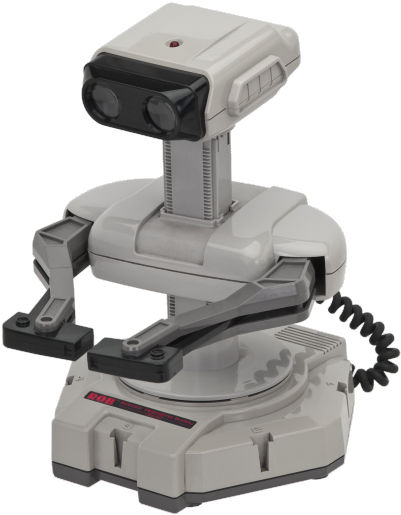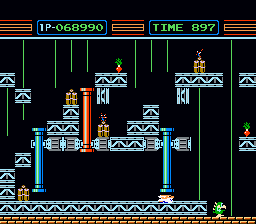I saw him in commercials. I saw him in magazines. I saw him displayed on shelves at every toy store in town. And over the course of several months, I saw him (or what remained of him) lying in the play-rooms of friends and cousins alike. That little fellow was everywhere, I tell you.
In all that time, though, I never got the chance to play around with him and find out what he was.
In all that time, I never got the chance to really know R.O.B. the Robot.
It happened, I'm pretty sure, because I was late to the party. I wasn't introduced to the NES until the early-to-mid portion of 1986, and by then, Nintendo was no longer making R.O.B.-focused games because the NES had proven itself to be so successful that it no longer had any need for its original marketing gimmick. So by the time I entered the scene, R.O.B. was simply out of style. He was a peripheral without a purpose.
I was oblivious to this history, of course, and thus short on context. And because I never actually paid attention to what was being said in any those TV commercials or magazine ads, I didn't know what R.O.B. was supposed to be. Hell--I wasn't even aware that he had game-related capabilities! I assumed, rather, that he was nothing more than a cute little pack-in prize--a robotic My Buddy whose only purpose was to move his arms from side to side and thus cheer you on as you played through NES games.
And by the time I learned about R.O.B.'s true purpose, it was too late for that information to matter. No one used him anymore. NES-owners had either thrown him away or tossed him aside.
So I never got an opportunity to see him in action.
And that's sad because one of the first NES games my friend Dominick introduced me to was Gyromite. It was one of two games programmed to work with R.O.B. (the other was the incomprehensible Stack-Up, whose action, from what I could tell, was equivalent to randomly pressing numbers on a touch tone phone). Unfortunately, though, playing it as it was intended to be played just wasn't an option for us.
It wasn't that Dominick didn't own a R.O.B., no. He did. He got it at launch. But by the middle of 1986, it was no longer functional. It stopped working because he and his brothers had been using it (and many other household objects) to beat each other over the head.
I had some strange friends, man (and this is coming from me--a guy who would take quarters and use them to scratch the clothes off of his rubber wrestling figures).
I'd never heard of Gyromite, so when Dominick handed me its cartridge, I didn't know what to make of it. I couldn't infer anything from its title because I had no idea what a "gyromite" was or how such an odd-sounding thing could relate to video games. So instead I tried to extract some information from the cartridge's artwork. And from what I could gather, Gyromite's was a harrowing tale of a stout doctor who rushes to defuse lit dynamite that's being guarded by a moving blue pillar and one of Marvin the Martian's instant-martian friends.
"So it's just another arcade-style platformer," I concluded.
At first, I didn't think that we'd actually be playing Gyromite (or "Robot Gyro," if the title screen is to be believed). I thought that Dominick had handed me the game's cartridge only because he wanted to prove ownership.
"He's showing me this game because he wants to impress me," I thought to myself. "I mean, obviously we're not going to be playing it! Not without a functioning R.O.B.!"
Moments later, though, Dominick made a surprising revelation: He informed me that there was a way to play Gyromite without R.O.B.'s assistance! We could play it, he explained, cooperatively, with one of us controlling the protagonist, Dr. Hector, and the other using the second controller to assist the effort by helpfully raising and lowering the red and blue pillars that were spread across each stage! Also, we could play an alternating two-player mode in which the roles would reverse after each death!
The whole concept sounded a bit space-age to me, honestly, though I was nonetheless intrigued by it. And, really, the action wasn't nearly as complicated as I originally thought. If you were controlling the protagonist, all you had to do to advance was collect the sticks of dynamite that were scattered across the stage and do your best to avoid the meddlesome green critters that were stalking you. You couldn't jump over critters (Dr. Hector lacked jumping ability), no, but you could temporarily distract them by feeding them or leading them to turnips; while they munched down on turnips, they'd ignore your presence.
But the true key to victory, I learned, was good teamwork. A lot of your success hinged on the second player and his ability to capably and reactively respond to commands. His role was to raise and lower pillars and thus remove barriers or help to elevate Hector up to otherwise inaccessible platforms, and if he could do that reliably, the two of you would achieve success.
Oh, and the second player, if he was engaged enough, could also take the time to squash any critter that walked onto or below a pillar! It was worth being the assisting player just to do that! Because squashing enemies was the one of the most fun things you could do in a video game (it was second only to throwing and knocking them off cliffs)!
In reality, though, we didn't function well at all. We were basically the Bad News Bears of Gyromite.
Dominick and I were incapable of creating synergy. We were always inadvertently blocking off each other's access and trapping each other in corners. We were constantly freaking out, in the most spastic fashion, and accidentally crushing each other. And this was happening because we couldn't handle two simple inputs. To us, apparently, keeping track of more than one input was akin to understanding rocket science.
Our sessions would usually play out the same way: We'd clear the first few stages pretty easily, then suddenly it would all fall apart. Our ineptitude, which we had done well to suppress, would predictably surface, and then we'd start to spaz out and continue to accidentally trap, block and squash each other. Then, after realizing that we had no hope of making meaningful progress, we'd turn mischievous and start to purposely screw each other over or at least threaten to do as much; and at that point, our Gyromite experience would devolve into a spiteful revenge game. And while that type of activity was fun, too, we'd soon grow bored of it and then move on to another game.
We weren't very good at Gyromite, no, but we were still fond of it. It was a fun, unique platformer, and it always made us laugh. We didn't play it as often as we did Balloon Fight, Ice Climber or any of our other multiplayer favorites, no, but whenever we'd pop it into either of our NESes, we'd proceed to derive a hefty amount of entertainment from its gameplay. Gyromite was, in our opinion, a true classic.
Though, one thing kept bugging me: I still didn't know what R.O.B. was designed to do! After you'd select a play mode, the screen would turn blue, and a prompt would tell you to "face forward," and this, I assumed, was the game's way or relaying a command to R.O.B. "But what's supposed to happen?!" I'd always wonder.
Dominick tried to explain it to me (he mentioned something about "infrared" and the picking up and dropping of "gyros"), but it sounded so complicated that I quickly zoned out and started thinking about something else (I was probably wondering, "Why are some mailboxes green?!"). All I knew was that R.O.B. was another a curiously experimental Nintendo product that went sadly unloved.
These days, you're likely to illicit groans if you mention Gyromite's name. Much like Ice Climber, Balloon Fight, Clu Clu Land, Pinball and other early NES works, Gyromite is considered to be "mediocre," and when it comes up in conversation, people are usually quick to dismiss it. This happens, I think, because most enthusiasts haven't actually played it (in cooperative-multiplayer mode, at least), and they've avoided it because, as far as they know, "it's just one of those silly, throwaway 'R.O.B.' games."
And this makes me sad because I know that Gyromite doesn't deserve such labels. It's not any of those things. Rather, Gyromite is a fun, creative arcade-platformer, and my fellow enthusiasts would undoubtedly recognize it as such if they took the time to play it for themselves and see what it actually is--see it the way my friends and I saw it.
Unfortunately, though, it seems that Gyromite is likely to remain obscure and unloved. And that's disappointing because it deserves better treatment--particularly from Nintendo, which basically ignores its existence. I mean, surely it's worth more of the company's attention than rubbish like Urban Champion, which, conversely, gets re-released every couple of years and is treated as though it's some type of all-time-classic. Right?
It would be cool if Nintendo were to revisit the concept. In an age in which wireless connectivity and Internet play are the norm, Gyromite's brand of cooperative would have a much better chance of clicking with the masses. And people learning to work together would certainly help to make the world a better place.
For that matter, so would the return of R.O.B., whose presence will surely serve to provide future generations of siblings just the item they need to more effectively beat each other over the head. And, really, what could be more important than that?
Do it for the children, Nintendo. Do it for love.











No comments:
Post a Comment